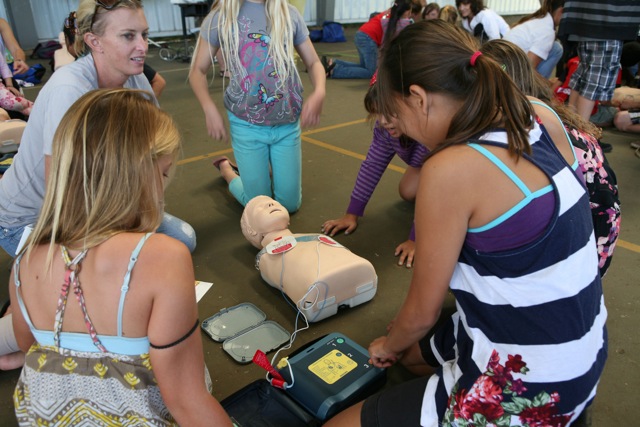Haiku School Receives AED and CPR Instruction
By Wendy Osher
Sixty-five students at Haiku Elementary School are now equipped with newly acquired life-saving skills.
Fifth grade students underwent training in the use of a new Automated External Defibrillator that was donated to the school by Fisher Construction LLC.
The students also received instruction in Cardio Pulmonary Resuscitation from paramedics and emergency medical technicians from the Maui County Paramedics Association.
The special instruction session on November 9 was organized by Paramedic Andrea Moller-Bouwens, and also featured instruction from Pamela Foster, founder of the Hawai’i Heart Foundation.
Students learned how to recognize a victim of cardiac arrest, perform hands-only CPR, and use their newly acquired AED in the hopes of being better able to respond to emergencies on campus and at home.
Organizers say students were taught that they are an integral part of the “Chain of Survival,” which begins with calling 911, starting chest compressions and using an AED while awaiting the arrival of emergency medical personnel.
Students also learned about the heart, how the heart functions and how to keep it healthy. The session included instructional videos, and hands-on instruction with the AED.
Alexander Fisher, the owner of Fisher Construction, the company responsible for the donation of the AED said, “My interests are twofold: one was to donate an AED to Haiku school, and another was to encourage other companies in donating AED’s and supporting student CPR instruction.”
According to Foster, nearly 350,000 people suffer from cardiac arrest outside of hospitals each year, and less than 30% will receive CPR from a bystander.
Without immediate bystander CPR and defibrillation, a victim’s chance of survival decreases 10% for each minute that passes, according to Foster.
“Depending on where you’re located in the county, it could take anywhere from 10 to 20 minutes for one of our advanced life support units to arrive at a patients side,” said Ryan Joslin, MCPA spokesperson. “These patients, and their ability to perform CPR and appropriately use an AED, are literally saved by the family members or the people in the communities in which they live or work.”
According to authorities, the national survival rate from cardiac arrest is less than 6 to 8% and potentially even less in Hawaii. “The problem for the past 50 years is that adults have been taught CPR yet the statistics are not improving,” said Foster.
“From an early age, children will learn critical skills relating to the chain of survival and to help save a life that will be reinforced as they progress through school,” said Moller-Bouwens, who is also the Maui County organizer for the Hawaii Heart Safe Schools Program.
Moller-Bouwens said it is hoped that by the time they graduate, there is a new generation of CPR/AED-savvy students who have the knowledge, confidence and willingness to save a life.













